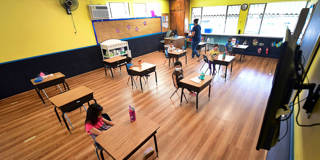If there is a potential silver lining to the United States' experience with COVID-19, it can be found in the domain of primary and secondary education, where the demand for alternatives to traditional public schools is surging. The pandemic has both laid bare the US education gap and pointed the way to a solution.
STANFORD – After years of rumblings for change in US education, the COVID-19 pandemic is becoming a catalyst for improving the system. America’s educational divide – especially in grades K-12 (elementary through high school) – is now clearly visible for anyone to see. Disparities in quality and access to education are a major source of the economic, social, and racial inequalities that are driving so much social unrest from Austin and Oakland to Portland and Seattle. Whether they come from impoverished inner-city neighborhoods or the suburbs, the least-educated Americans have been the hardest hit by the pandemic and its economic effects.
Fortunately, economist Thomas Sowell (my colleague at the Hoover Institution) has offered a solution. In his new book, Charter Schools and Their Enemies, he shows that schools with more autonomy and flexibility than traditional public schools are closing the educational divide, providing sorely needed choice, opportunity, and competition.
Sowell’s careful analysis of the data, which was available before the pandemic struck, shows that students in publicly funded but privately operated charter schools like Success Academy in New York City score remarkably higher on standardized achievement tests than do those in traditional public schools. The book contains reams of convincing evidence, all of which is explained beautifully and presented clearly in more than 90 pages of tables.

STANFORD – After years of rumblings for change in US education, the COVID-19 pandemic is becoming a catalyst for improving the system. America’s educational divide – especially in grades K-12 (elementary through high school) – is now clearly visible for anyone to see. Disparities in quality and access to education are a major source of the economic, social, and racial inequalities that are driving so much social unrest from Austin and Oakland to Portland and Seattle. Whether they come from impoverished inner-city neighborhoods or the suburbs, the least-educated Americans have been the hardest hit by the pandemic and its economic effects.
Fortunately, economist Thomas Sowell (my colleague at the Hoover Institution) has offered a solution. In his new book, Charter Schools and Their Enemies, he shows that schools with more autonomy and flexibility than traditional public schools are closing the educational divide, providing sorely needed choice, opportunity, and competition.
Sowell’s careful analysis of the data, which was available before the pandemic struck, shows that students in publicly funded but privately operated charter schools like Success Academy in New York City score remarkably higher on standardized achievement tests than do those in traditional public schools. The book contains reams of convincing evidence, all of which is explained beautifully and presented clearly in more than 90 pages of tables.